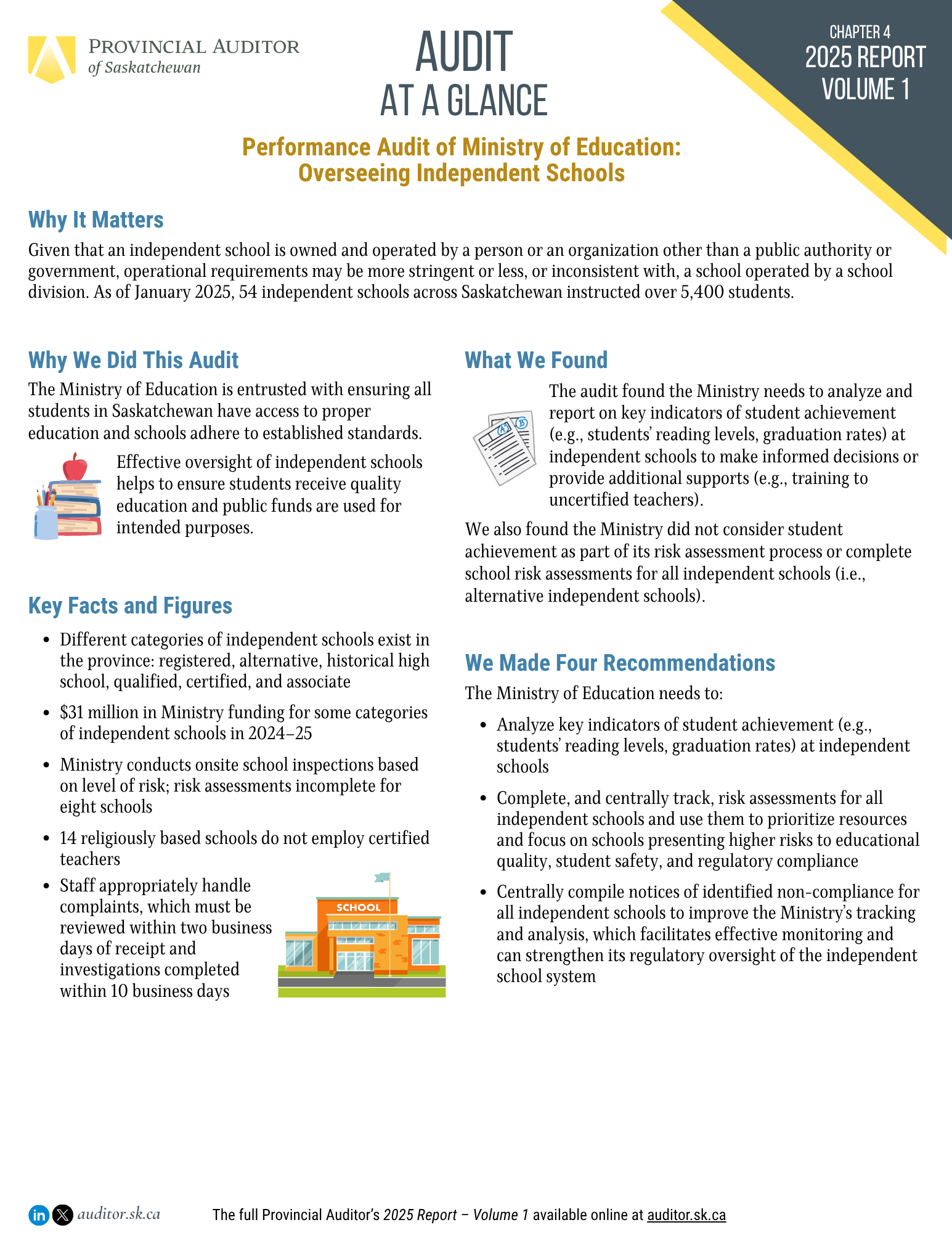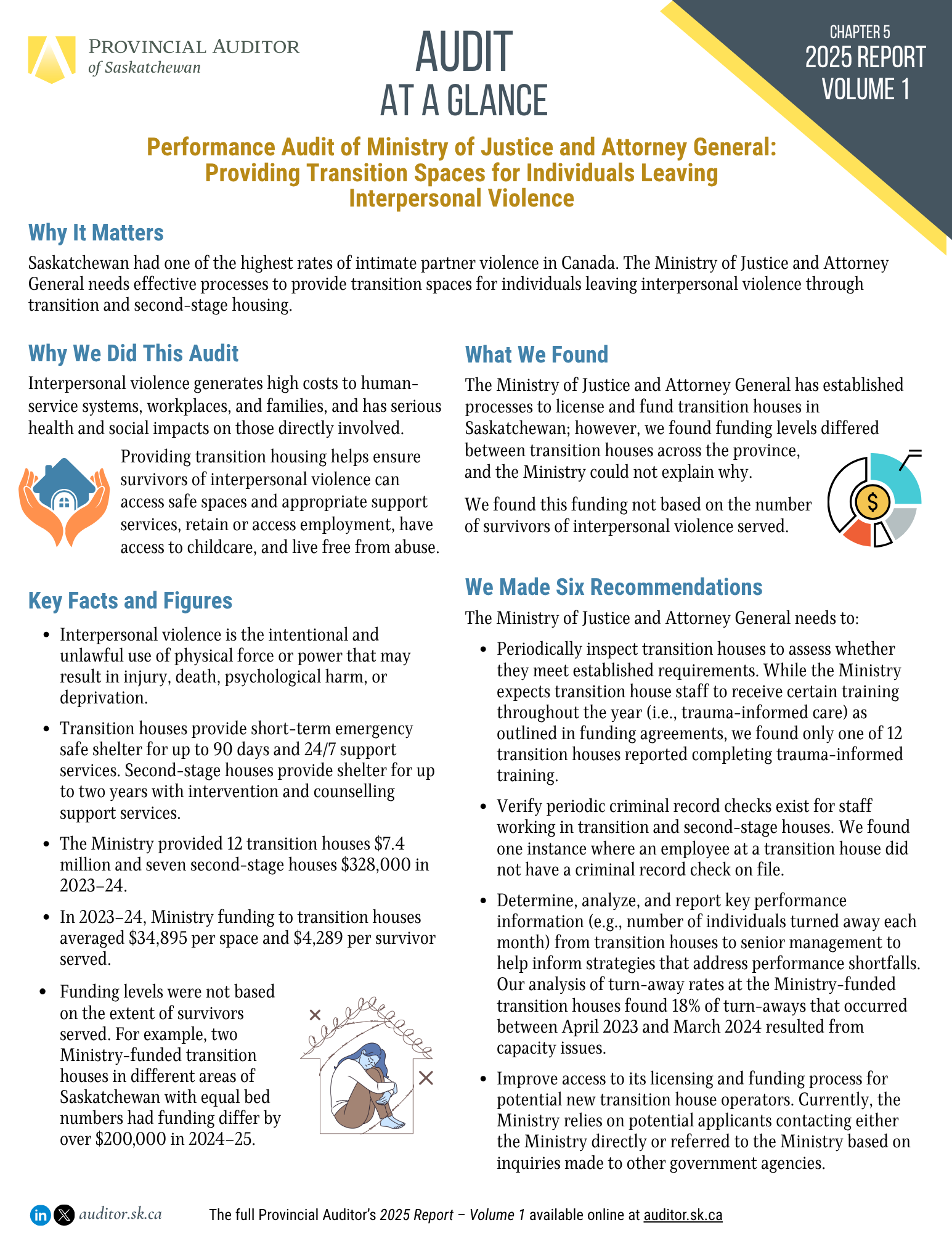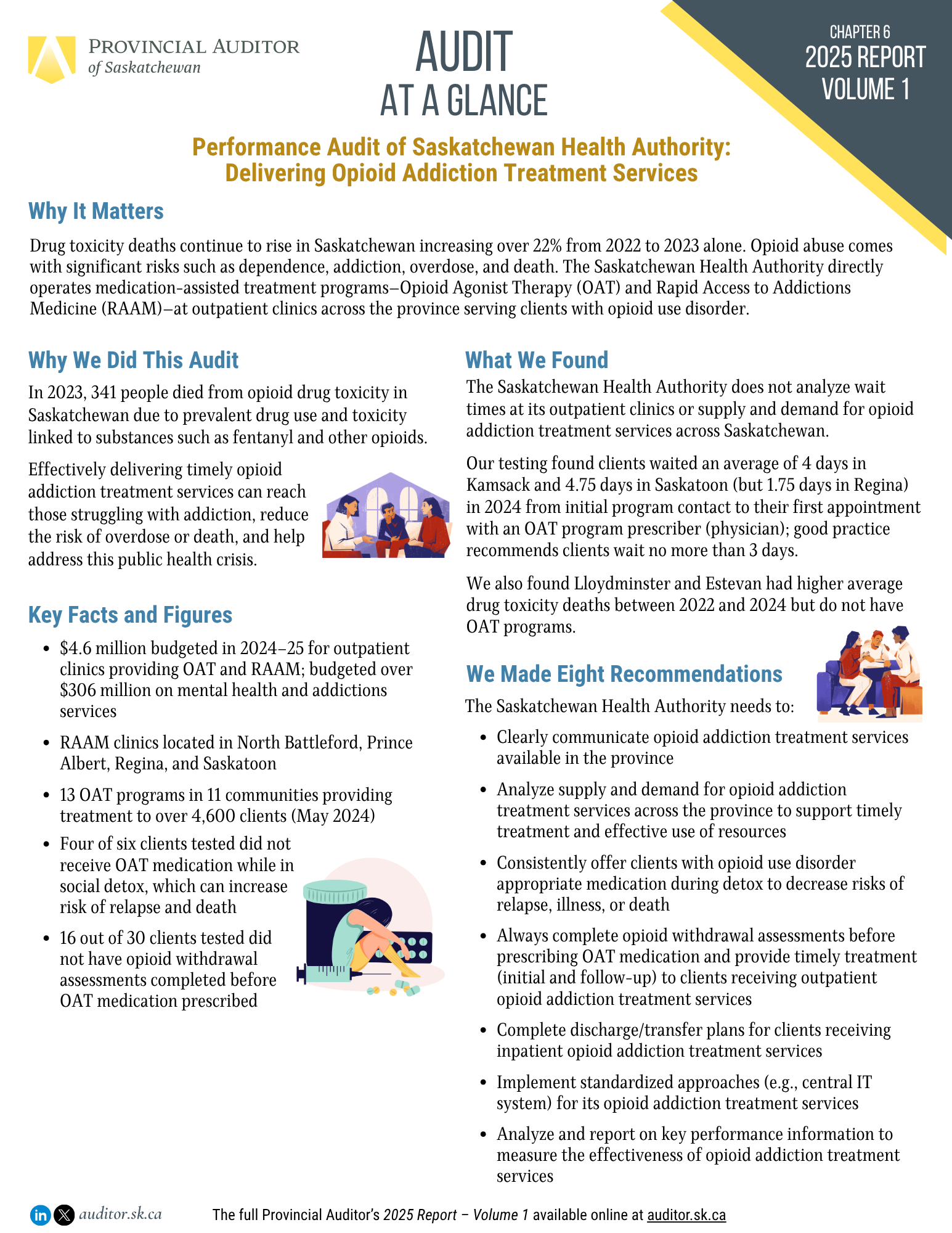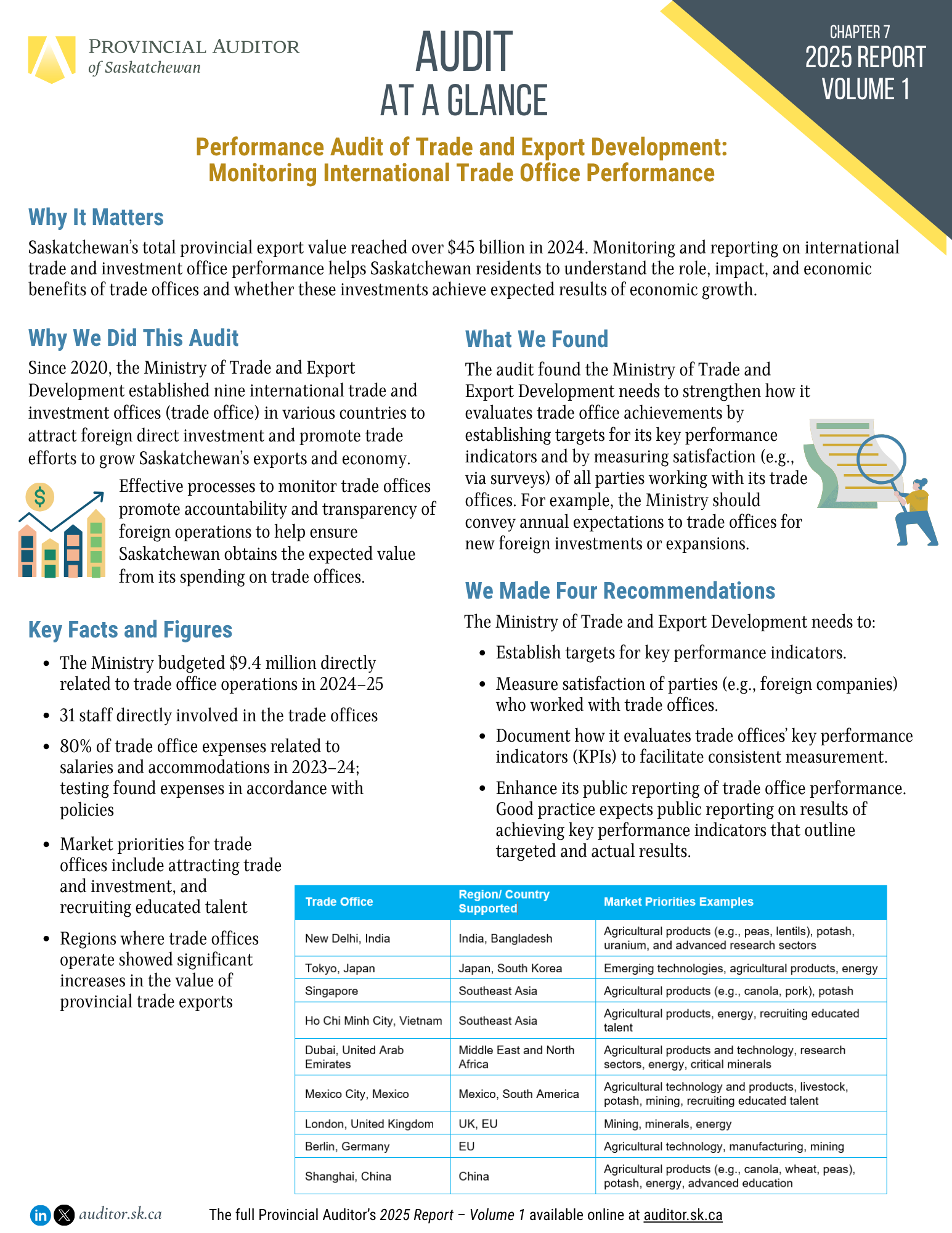2025 Report Volume 1
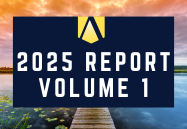 June 3, 2025
June 3, 2025
2025 Report – Volume 1
Scroll to view each audit chapter separately.
This 2025 Report – Volume 1 delivers legislators and the public critical information on whether the Government issued reliable financial statements, used effective processes to administer programs and services, and complied with governing authorities. It includes the results of audit examinations of different agencies completed by April 30, 2025, with details on annual integrated (financial) and performance audits, as well as our follow-up audit work on previously issued recommendations by our Office and agreed to by the Standing Committees on Public Accounts or on Crown and Central Agencies.
Annual Integrated Audits
Since our 2024 Report – Volume 2, our Office, along with appointed auditors (if in place), completed annual integrated audits of 57 different agencies with fiscal year-ends between July and December 2024. These include integrated audits of all 27 school divisions and 16 pension and employee benefit plans.
This section of our Report outlines concerns related to financial-related controls at 19 out of the 27 school divisions and the need for better governance controls at the Saskatchewan Distance Learning Corporation.
Saskatchewan’s 27 school divisions (Chapter 2) had expenses of $2.5 billion for 2023–24. Strong financial-related controls are needed at various school divisions to properly safeguard public resources. We found certain school divisions did not properly review bank reconciliations; approve electronic fund transfers; independently approve journal entries; or segregate incompatible duties in their IT systems. Not doing so increases the risk of fraud and not detecting errors. Also, several school divisions across the province still require an adequate process to sufficiently monitor their key financial IT system and its related IT service provider to reduce the risk of system downtime or unauthorized access—we recommended in 2021 that they do so. School divisions remain responsible for managing risks associated with their IT systems and data even when using a service provider.
Established in 2022, the Saskatchewan Distance Learning Corporation (Chapter 1) requires stronger governance controls to help it fulfill all its legislative requirements. The Corporation’s Board (i.e., Minister of Education) needs to document and make public its board meeting minutes, approve annual budgets, and receive adequate financial forecasts. This will keep records of key governance processes and decisions made as well as demonstrate the Board provides proper oversight of the affairs and business of the Corporation.
Performance Audits
Performance audits take a more in-depth look at processes related to the management of public resources or compliance with legislative authorities. Performance audits span various topics and government sectors. In selecting which areas to audit, we attempt to identify topics with the greatest financial, social, health, or environmental impact on Saskatchewan. This Report includes the results of four performance audits highlighted 'At a Glance':
Audit At a Glance Education—Overseeing Independent Schools
Audit At a Glance Saskatchewan Health Authority—Delivering Opioid Addiction Treatment Services
Audit At a Glance Trade and Export Development—Monitoring International Trade Offices
Follow-up Audits
This section of the Report highlights the results of 14 follow-up audits, as well as summarizes how quickly government agencies addressed our recommendations and made process improvements.
As shown in the Figure 1 below, 60% of the audit recommendations in this Report were fully implemented after the initial follow-up (i.e., 2–3 years after original audit) at the various agencies. For agencies with subsequent follow-ups in this Report, 87% of audit recommendations have been fully implemented. We are pleased to see agencies acting on our recommendations in a timely manner, as this means public sector management is improving.
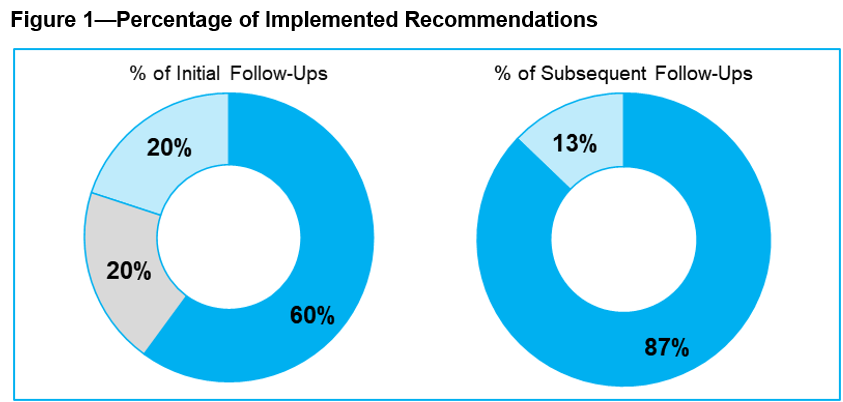
Saskatoon School Division No. 13 (Chapter 18) fully implemented the outstanding recommendations we first made in 2021 related to monitoring its success in readying students for learning in the primary grades when exiting kindergarten. The Division reported kindergarten student readiness for schools across the Division in spring 2024 was 78.2%—a nearly 20% increase from 59% recorded in fall 2023—demonstrating effectiveness of actions taken that resulted from its improved data analysis and new tools (online dashboard).
However, further work is needed at some government agencies.
The Ministry of Education (Chapter 8) has yet to fully strengthen its processes related to implementing its Inspiring Success Framework to improve educational outcomes for Indigenous students. Although the Ministry expanded measures for academic achievement beyond graduation rates for Indigenous students, it has not developed quantifiable targets for those expanded measures. For example, it has not defined how much Indigenous student attendance should improve annually to gauge success.
While school divisions began reporting results for both Indigenous and non-Indigenous students separately, we found the reporting lacked sufficient detail to quantify success because results were not compared to targets. Without Indigenous-specific, measurable targets, it is difficult for the Ministry, school divisions, and the public to determine whether key strategies, actions, and initiatives successfully increase Indigenous student success and work as intended. At June 2023, about 48% of Indigenous students graduate within three years of starting Grade 10 compared to 88% of non-Indigenous students.
The Public Service Commission (Chapter 11) also has more work to do in advancing workplace diversity and inclusion in ministries. The Commission still needs to establish clear indicators (targets), analyze relevant data, and then report progress toward achieving cross-ministerial inclusion and diversity goals. A lack of specific targets impedes clear expectations and appropriate assessment of progress.
In addition, the Commission does not yet sufficiently monitor ministries’ diversity and inclusion plans and progress reports—it had yet to receive a diversity and inclusion plan from 67% of the ministries it oversees as of November 2024. Analyzing these plans and progress reports would help the Commission to identify where to assist ministries with implementing actions for increasing diversity and inclusion in their workplaces. For example, at March 31, 2024, only 8.8% of Indigenous Peoples were employed across ministries (below the Saskatchewan Human Rights Commission’s recommended target of 15.2%). Advancing workplace diversity and inclusion can assist ministries in providing better public services.
Media Materials 2025 Report – Volume 1
- Compilation of All Audits' Main Points/Executive Summaries
- 2025 Report V1: Delivering Opioid Addiction Treatment Services NEWS RELEASE
- 2025 Report V1: Transition Spaces for Interpersonal Violence Survivors NEWS RELEASE
- 2025 Report V1: BACKGROUNDER
2025 Report Volume 1 Press Conference by Provincial Auditor Saskatchewan
Full 2025 V1 Report
Provincial Auditor of Saskatchewan's Overview
Tara Clemett's Complete Overview 2025 Report – Volume 1
Table of Contents
2025 Report – Volume 1 Table of Contents
Annual Integrated Audits
1 Saskatchewan Distance Learning Corporation
3 Summary of Implemented Recommendations
Performance Audits
4 Education—Overseeing Independent Schools
6 Saskatchewan Health Authority—Delivering Opioid Addiction Treatment Services
7 Trade and Export Development—Monitoring International Trade Offices
Follow-Up Audits
8 Education—Improving Educational Outcomes for Indigenous Students
9 Environment—Sustainable Fish Population Management
11 Public Service Commission—Advancing Workplace Diversity and Inclusion in Ministries
13 Saskatchewan Health Authority—Purchasing Goods and Services
14 Saskatchewan Health Authority—Safe and Timely Discharge of Patients from Regina Hospitals
15 Saskatchewan Health Authority—Treating Patients at Risk of Suicide in Northwest Saskatchewan
16 Saskatchewan Liquor and Gaming Authority—Regulating Locally Manufactured Craft Alcohol
17 Saskatchewan Research Council—Purchasing Goods and Services
18 Saskatoon Public School Division No. 13—Kindergarten Readiness to Learn
19 SaskBuilds and Procurement—Securing the Data Centre
20 SaskPower—Planning the Shut Down and Decommissioning of Boundary Dam
21 Water Security Agency—Ensuring Dam Safety
Appendices
1-1 Agencies Subject to Examination under The Provincial Auditor Act and Status of Audits
2-1 Report on the Financial Statements of Agencies Audited by Appointed Auditors
All Prior Reports
All prior reports are available here for your reference.
Acknowledgments
Our Office continuously values the cooperation from the staff and management of government agencies, along with their appointed auditors, in the completion of the work included in this Report. We appreciate the many experts who shared their knowledge and advice during the course of our work.
We also appreciate the ongoing support of the all-party Standing Committees on Public Accounts and on Crown and Central Agencies, and acknowledge their commitment in helping to hold the Government to account. Our Office remains focused on serving the Legislative Assembly and the people of Saskatchewan; we are committed to making a difference for a sustainable Saskatchewan and its people.



